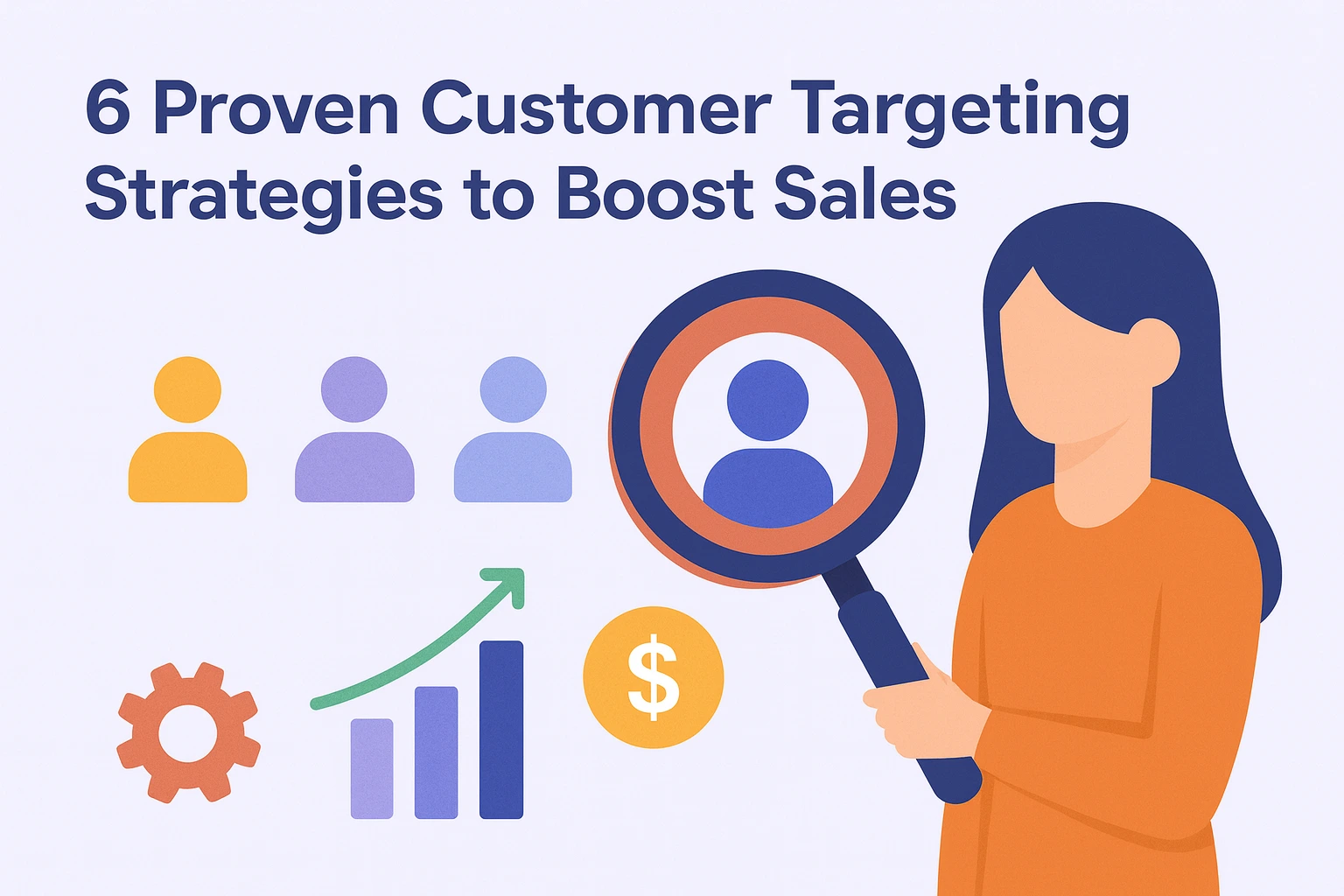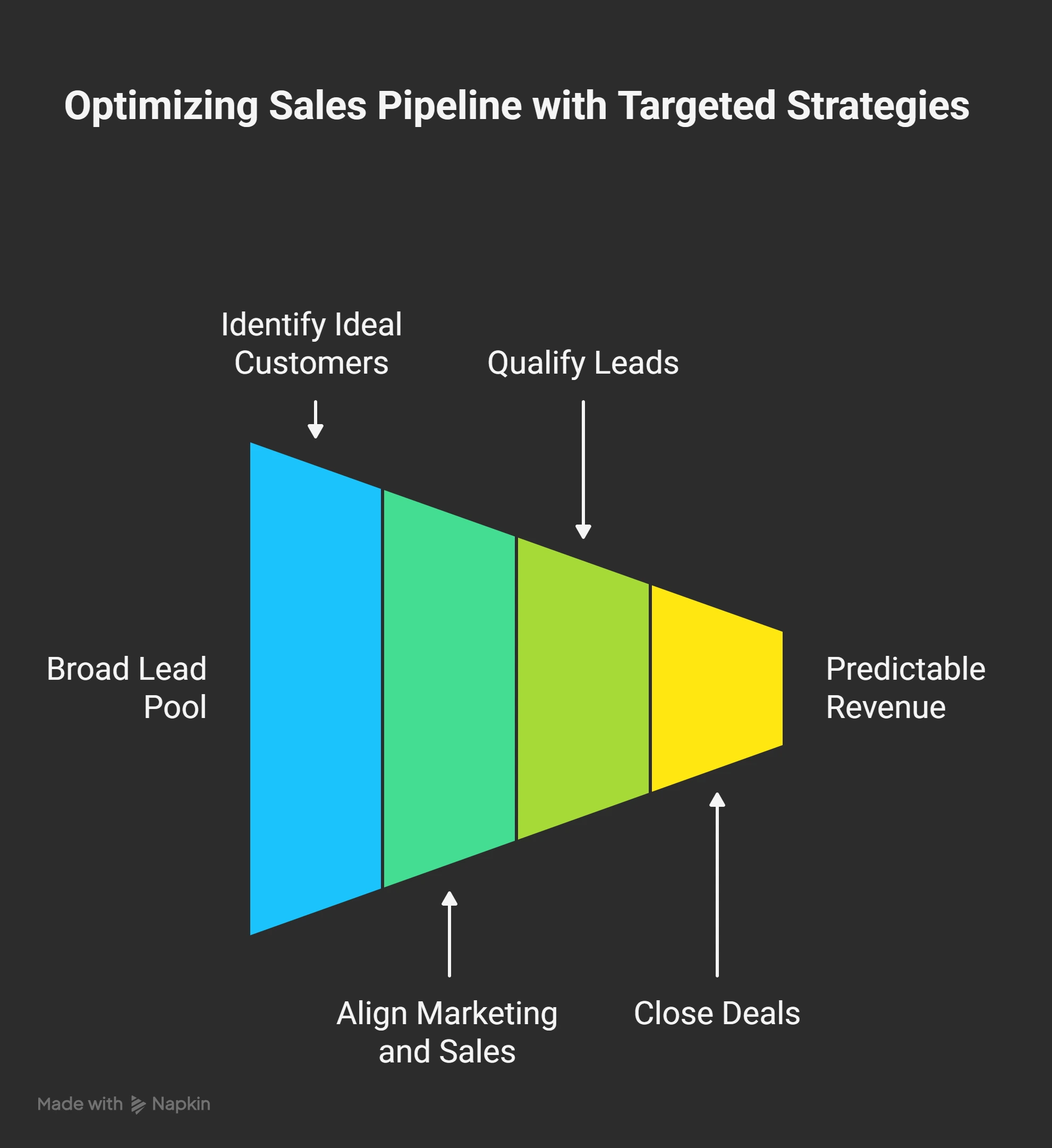
6 Proven Customer Targeting Strategies to Boost Sales
Summary:
Strong customer targeting strategies can make or break your sales pipeline. When your team focuses on the right prospects, every conversation counts, fewer wasted calls, more qualified leads, and faster deal closures. By aligning your marketing and sales efforts with clear data, segmentation, and an ideal customer profile, you can turn random outreach into predictable revenue.
To keep your pipeline growing consistently, precision is key. Instead of chasing every lead, focus on those who truly fit your solution. Smarter targeting not only improves conversion rates but also boosts your team’s confidence and efficiency. Ready to put these strategies into action? Book a demo with PowerDialer.ai to reach the right customers faster and maximize every sales opportunity.

Customer targeting strategies are the key to every successful marketing and sales campaign. Without them, teams end up with the universal problem of pursuing unqualified prospects, getting bogged down for hours dialing or sending outreach emails that never turn into anything.
The truth is straightforward: there are too many overworked but under-smart sales teams that spend hours and hours loading up their pipeline with promising-looking prospects on paper, but ultimately, no buying intent, no budget, or no authority. The consequences are bloated pipelines, frustrated reps, and declined revenue targets.
But here's the silver lining, this can be rectified. With effective customer targeting techniques, you can ensure your sales team targets only the correct leads. This doesn't only save time, it decreases sales cycles, enhances pipeline conversion rates, and achieves measurable sales pipeline expansion.
Here in this guide, we will dissect 6 customer targeting techniques used by successful B2B sales teams to meet quotas consistently, develop high-quality pipelines, and optimize ROI.
Why Customer Targeting Is Key to Pipeline Growth

Targeting isn't a marketing buzzword, it's a growth factor. In B2B, where deals are typically large and buying cycles lengthy, accurate targeting distinguishes successful sales teams from unsuccessful ones.
The Cost of Targeting the Wrong Customers
Targeting the wrong audience can cripple your pipeline. Imagine spending weeks nurturing a lead, running demos, and customizing proposals, only to discover the company has no budget or authority to purchase. Not only is time wasted, but sales reps lose momentum and morale.
Industry data shows that poor targeting results in:
- Lower conversion rates: More conversations that go nowhere.
- Longer sales cycles: Prospects take longer to say "no" or drop off.
- Higher cost of acquisition: More investment in marketing and outbound with lower return.
That is, the incorrect prospects aren't only unprofitable, they are actually detrimental to pipeline health.
The ways in which Customer Targeting enhances Lead Quality
Effective targeting means every prospect in your pipeline has a greater likelihood of converting. When sales teams focus exclusively on qualified leads that align with the ideal customer profile (ICP), they can:
- Enhance lead qualification at the top of the funnel.
- Target effort on accounts with authentic interest.
- Brevity in sales cycles with high-intent buyers.
Improved lead quality equals more substantial conversations, more robust opportunities, and greater revenue per rep.
The Connection Between Targeting & Pipeline Acceleration
Pipeline acceleration is the holy grail of sales expansion. Targeting speeds up pipelines by:
- Cutting out wasted time on unsuitable accounts.
- Having marketing and sales align around common priorities.
- Bolstering conversion rates through relevance and personalization.
When precision targets are used, all outreach, cold calls, LinkedIn messages, or emails, is more impactful. This energy keeps the deals flowing and pipeline optimization consistent.
6 Customer Targeting Strategies That Work
Let's now turn to the six strategies that continually prove themselves for high-performing sales teams.
1. Create an Ideal Customer Profile (ICP)
Strong ICP Key Elements
Your ideal customer profile (ICP) is the roadmap of what your best-fit customer looks like. For B2B, this would be:
- Firmographics: Company size, location, annual revenue, industry.
- Technographics: Tools, platforms, or technologies the company employs.
- Pain Points: Business issues your product addresses.
For instance, a SaaS dialer business could have its ICP as: "Mid-market B2B businesses with 50–200 sales reps, making $10M–50M in revenue, already using older phone systems and having issues with connect rates."
How ICP Directs Smarter Outreach
When you know your ideal customer, outreach is laser-guided. Rather than shooting 1,000 emails to random businesses, your team targets the 200 that are most likely to purchase.
This guarantees:
- Increased connect rates.
- Briefer qualification calls.
- More deals won through fewer touches.
Tip: ICP doesn't stay static. Refresh and update quarterly based on closed and lost deals.
2. Leverage Customer Segmentation
Segmentation enables you to bucket prospects based on common characteristics, which makes outreach more targeted.
Demographic Segmentation
More prevalent in B2C but can still be useful in SMB sales. Examples: geographic location, job function, or age range (for user-level outreach).
Firmographic Segmentation for B2B
Firmographic segmentation is essential in B2B. You are able to segment accounts based on:
- Company size (SMB, mid-market, enterprise).
- Industry vertical (tech, finance, healthcare).
- Growth stage (start-up vs. established).
Each segment tends to need distinct messaging and value propositions.
Behavioral Segmentation
Prospect behavior segmentation lets you focus on high-intent leads. Examples:
- Visits to product pages on the website.
- Free trial registrations.
- Attendees at webinars.
This type of segmentation is a perfect complement to target audience analysis, making reps aware of who is nearest to purchasing.
3. Leverage Data-Driven Insights
Data drives today's sales. Without data, targeting is guessing.
Predictive Analytics in Targeting
Predictive sales analytics employs AI and past experience to predict which leads are more likely to convert. For instance, it can use patterns in past deals to determine which industries or job functions close most quickly.
CRM and Enrichment Tools for Data Accuracy
A tidy CRM is not negotiable. Lead enrichment tools assist with guaranteed accurate contact information, current job titles, and proper company names. This avoids wasted calls and allows your team to reach the correct decision-makers.
Real-World Example of Data-Driven Targeting
A SaaS firm applied lead scoring (on engagement indicators such as webinar participation and email opens). Their reps only concentrated on "hot" leads whose scores were over a certain threshold. The outcome? A 40% hike in pipeline conversion rates in one quarter.
4. Prioritize High-Value Accounts with ABM
Why ABM Aligns Sales & Marketing
Account-based marketing (ABM) turns the classic funnel on its head. Rather than throwing a broad net, sales and marketing teams collaborate on a shortlist of high-value accounts.
This achieves perfect alignment, both teams aim to win the same accounts with unified messaging.
Personalization at Scale
ABM allows for personalized campaigns per target account. This might be custom landing pages, tailored email workflows, or even account-specific display ads.
Case Study-Style Success Example
A cybersecurity firm implemented ABM to pursue Fortune 500 companies. By personalizing their approach to every CIO and IT department, they grew enterprise pipeline revenue by 35% in six months.
5. Create Customer Personas
Difference Between ICP and Personas
Consider ICP the "company fit" and customer personas the "human fit." ICPs define companies that are a fit for your product; personas outline the people within those companies.
Mapping Pain Points & Buying Motivations
For example:
- CFO Persona → ROI and cost savings driven.
- Sales VP Persona → Effective at quota achievement and accelerated deal velocity.
- IT Director Persona → Security and integrations-focused.
Applying Personas to Content & Outreach
By creating content from personas, sales scripts and campaigns become more pertinent. Sending a case study of cost savings to a CFO rather than a generic product sheet, for instance, drives up response rates.
6. Test & Optimize Targeting Strategies Continuously
A/B Testing Messaging & Channels
Sales and marketing must test various methods on an ongoing basis, subject lines, CTAs, cold call openings, LinkedIn ads, to discover what works best.
Feedback Loops from Sales Teams
Reps are on the ground. Their feedback regarding which leads are most active assists marketing in refining targeting criteria.
Tuning In Based on Market Changes
Industries change. Tools evolve. Buyer behavior changes. Periodic examination of your customer targeting strategies keeps your playbook from growing stale.
Avoidable Mistakes to Steer Clear of in Customer Targeting
Even with the proper framework, most teams fall victim to preventable blunders:
- Overgeneralizing audiences: Targeting "all mid-market SaaS companies" is too broad. Drill down.
- Ignoring data signals: Leads that download your whitepaper are more valuable than random cold calls.
- Targeting too broad or too niche: Balance is key, don’t cast too wide or you’ll dilute results; don’t go too narrow or you’ll run out of prospects.
Conclusion
At its essence, sales success is not about pursuing every lead, it's about pursuing the right ones. With smarter customer targeting strategies, you can enhance lead quality, reduce sales cycles, and realize real sales pipeline growth.
Keep in mind: pipeline growth is a byproduct of precision, not quantity.
Ready to revolutionize your sales pipeline with smarter targeting?
Schedule a demo with PowerDialer.ai today and learn how to bypass gatekeepers, engage faster, and close more deals.
Frequently Asked Questions (FAQs)
Q1: What is customer targeting in sales?
A: Customer targeting is the act of identifying and targeting outreach at prospects that are most likely to convert, segmented and based on data.
Q2: How do customer targeting strategies increase pipeline growth?
A: They minimize wasted effort, enhance lead quality, and enable sales reps to close deals more quickly by working only on qualified prospects.
Q3: What are some tools that facilitate targeting customers?
A: Tools such as CRM platforms, lead enrichment software, predictive analytics, and dialers like PowerDialer.ai automate outreach.
Q4: How is ICP different from customer personas?
A: ICP specifies the kind of company you wish to sell to, whereas personas outline the decision-makers in those companies.
Q5: How often do I need to update my targeting approaches?
A: Update quarterly or whenever buyer behavior, product offerings, or market trends change.
